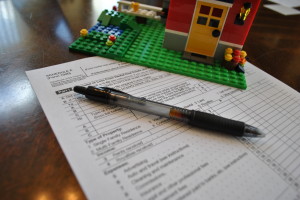Whether you have a rental property for investment reasons or, like many military families, it’s time to PCS, you need to complete and attach IRS Schedule E to your 1040. This information is based on both my personal experience investing in rental real estate and common errors I’ve seen new clients make on their tax returns.
Management companies are a must for most landlords. Take the time before you start renting to interview potential rental management companies. This is especially important if you won’t be living in the same area. Here’s a good read on what questions you should be asking. The fee they charge is deductible on Sch E, line 11.
Arrange all receipts in separate files, labeled as follows, to correspond with lines 5-17 and 19 on Schedule E. Ask your management company to provide this information to you already categorized.
- Advertising
- Auto and travel
- Cleaning and maintenance
- Commissions
- Insurance
- Legal and other professional fees
- Management fees
- Mortgage interest paid to banks, etc.
- Other interest
- Repairs
- Supplies
- Taxes
- Utilities
- Other (e.g. HOA fees and pest control)
Depreciation is an annual deduction taken to recapture the cost of your rental property over 27.5 years, minus your land value. Depreciation begins on the first day the property becomes a rental and ends when sold. Items often forgotten that should be depreciated include appliances, fencing and permanent shrubbery, furniture, carpet, and new roofing. Depreciation information is reported on Sch E, line 18. Keep your yearly depreciation schedules and/or ensure your tax preparer is providing them to you as you will need this information when you sell.
Eliminate reporting mortgage interest, taxes, and insurance on Sch A if the home was previously used as your primary residence. You must now include those amounts only on Sch E, lines 9 and 12. This may result in you having to take the standard deduction instead of itemizing deductions. If the property switched to a rental during the year, count the number of days it was held for each use and report the amounts appropriately between Sch A and Sch E.
Elect “active participation” if you were involved with management decisions or arranged for others (like your management company) to provide services such as repairs and approving new tenants. This election will allow you to deduct up to $25,000 of total rental property passive activity losses annually, as long as your modified adjusted gross income (MAGI) is less than $100,000 ($50,000 for married filing single). If your allowed loss is greater than $25,000, you may carry additional amounts forward in the following year(s). Your Sch E total should be reported on Form 1040, line 17 as a positive number (net income) or negative number (net loss).
Adjust your cost basis as follows:
Purchase price
+ Purchase costs (title & escrow fees, real estate agent commissions, etc.)
+ Improvements (replacing the roof, new furnace, etc.)
– Selling costs (title & escrow fees, real estate agent commissions, etc.)
– Accumulated depreciation (as reported on your tax forms)
= Cost Basis
Selling your rental requires a few more forms (surprise, surprise). Unless you have a clear understanding of the tax rules or have the patience to read this, seek help on this one.
You MUST check on your property regularly. You can deduct necessary auto and travel expenses and 50% of meals for a single taxpayer to travel to the property. Not to mention, your management company will more likely stay on their game if they never know when you’ll be dropping by the house. Asking for dated pictures and asking your neighbors are also great ways to check on the condition of the home between visits. Never leave the success of your rental property up to someone else!

